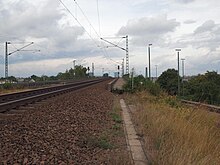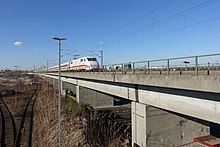Container station bridge Mannheim
Coordinates: 49 ° 28 ′ 4 " N , 8 ° 29 ′ 36" E
| Container station bridge Mannheim | ||
|---|---|---|
| ICE turns from the ramp onto the container station bridge | ||
| use | Railway bridge | |
| place | Mannheim | |
| construction | Girder bridge | |
| overall length | 1,100 m | |
| start of building | 1976 | |
| completion | circa 1978 | |
| opening | 1987 | |
| location | ||
|
|
||
The container Bahnhofsbrücke Mannheim is a railway - girder bridge of Mannheim-Stuttgart high-speed railway in Mannheim ( kilometer 2.0 to 3.1). The overpass, built between 1976 and 1978, was the first completed engineering structure on the route. With a length of 1,100 m it is the longest railway bridge in Baden-Württemberg and one of the longest railway bridges in Germany .
Among other things, the bridge crosses the former container station in Mannheim and therefore bears its name.
The construction costs amounted to around 21 million DM . In mid-1978 DM 17 million had been reported.
course
The structure begins at 1,400 kilometers .
The route of the bridge runs in a south-easterly direction in the form of an S-curve between the main station and the Pfingstberg tunnel . At the north-western end, a bridge structure at an acute angle spans four tracks on the railway line to Heidelberg and a siding of the marshalling yard and the Mannheim container terminal. This is followed by the middle section of the bridge, with standard spans of 25 meters, interrupted by a further overpass structure for a track.
In the last 150 meters, two more tracks will be spanned and the two tracks will be spread. The center distance of the tracks is increased here from 4.70 to 25.80 m to enable a later introduction of the eastern Riedbahn. A connection with the marshalling yard could be established via a ramp. Freight trains could thus bypass Mannheim Central Station. The subsequent Mallau earthworks lot was also carried out with the increased track spacing.
The gradient initially rises by 16.0 per mille on the western ramp, rises largely by 3.4 per mille on the bridge and drops by 12.5 per mille in front of the eastern abutment and on the eastern ramp.
The maximum permissible speed in the building sector today (as of approx. 2008) is 100 km / h (up to km 2.0), 160 km / h (km 2.0 to 3.0) or 190 km / h (from km 3.0).
construction
The north-western crossing of the station tracks is made with a raised, 216.4 m long plate beam construction , which is supported by individual supports. In the normal range, the bridge superstructure has a pillar spacing of 25 m and consists of two single-track superstructures with a chain of 24 single-span girders as a static system . In cross-section, they consist of single-celled, 2.4 m high and 23.35 m wide reinforced concrete hollow boxes, prestressed in the longitudinal direction . In addition, the 6.81 m wide deck is prestressed in the transverse direction. The production of two bridge girders was carried out every week on falsework . First the floor slab with the webs was concreted and in the second step the carriageway slab. The superstructures are supported on reinforced concrete pillars that have a box-girder cross-section and are supported by six 18 to 22 m long bored piles with a diameter of 1.5 m each. The standard section is interrupted by a further 75.75 m long plate beam construction and closed at the southeast end by a 150 m long section. This is where the two track axes begin to spread to up to 25.80 m as a preliminary construction work for the later threading of the eastern Riedbahn. The bridge superstructure here consists of a chain of lower two-span girders that have a three-cell box girder cross-section and rest on individual pillars.
history
planning
The necessity of a flyover structure resulted from the planned operating program, which made a height-free connection to the new line necessary.
Already in the planning status of 1973 a height-free threading of a connecting line between the eastern introduction of the Riedbahn and the new line, bypassing the Mannheim main station, was planned. The connecting line was to unwind from the Riedbahn southeast of Mannheim Central Station, before the branching of the Riedbahn introduction (towards Hauptbahnhof and Heidelberg), run parallel to the existing line to Heidelberg to the north and finally merge into the new line at no elevation.
The bridge was part of the planning approval sections 1b (km 1.700 to 2.300) 1b and 1c (km 2.300 and km 9.585) of the Mannheim – Stuttgart high-speed line . The plan approval procedure was initiated on August 5, 1974 (1b) and April 7, 1975 (1c). The discussions took place in 1975. The resolutions were passed on July 10, 1975 (1b) and March 26, 1975 (1c) and became legally effective on August 10, 1975 (1b) and April 26, 1976 (1c). One objection was raised against the project in Section 1b and 112 objections in Section 1c. There were no complaints in either section.
Due to the comparatively large proportion of bridges planned for new and upgraded lines of the Federal Railroad, a model was to be developed that could also be used elsewhere under similar terrain conditions. The requirements included a superstructure with a continuous ballast bed, minimal longitudinal displacements and deflections, and the simplest and most economical construction possible with low maintenance costs. The bridge thus became the prototype of a standardized construction method for bridges developed by the Mainz Central Transport Authority.
construction
The preparatory work in the area of the Mannheim container station began in March 1976 with the clearing of the construction site. Among other things, station and line tracks, cables and roads were laid, and high-rise buildings were demolished and rebuilt. A total of 16 kilometers of track and 88 points were laid. The total costs for these measures were put at around 16 million DM.
Construction work began on May 19, 1976.
On August 20, 1976, Federal Transport Minister Kurt Gscheidle carried out the symbolic first pile-driving of the new line at the bridge .
The construction work turned out to be difficult because of the poor subsoil and the intensive train operation. The bridge was largely built using a modular system of 25 m long prestressed concrete parts.
The bridge was the first structure on the new line to be completed in 1978. (Another source speaks of completion in the shell by December 14, 1979.)
In the summer of 1978 the structure was largely completed.
A total of 4,520 m of concrete piles (150 cm diameter), 28,200 m³ of concrete , around 350 t of prestressing steel and around 2,600 t of structural steel were used .
Most of the orders for the building, which cost around DM 21 million, were awarded to companies from Baden-Württemberg.
For the south-east adjoining earthworks section, 55,000 m³ were removed and a railway embankment formed from 126,000 m³ of material. In addition, 6.5 km of roads and several kilometers of cables and canals were laid. The planned total costs for this 2.5 km long section in 1978 were 10 million DM.
The bridge has been used by regular trains since the end of May 1987.
technology
To reduce noise emissions from trains, the bridge has a sound-absorbing ballast bed .
In the area of the bridge, the line train control of the high-speed line begins .
Web links
Individual evidence
- ↑ a b c d Bridge building in a modular system . In: The Federal Railroad . tape 54 , no. 8 , 1978, ISSN 0007-5876 , pp. 564 .
- ↑ a b c d e f g h i j Horst Keuert: Status of construction work on the new Mannheim – Stuttgart line . In: Die Bundesbahn , 1978, No. 8, pp. 588-592.
- ^ A b Horst J. Obermayer: New routes for the InterCityExpress . In: Herrmann Merker (Ed.): ICE - InterCityExpress at the start . Hermann Merker Verlag, Fürstenfeldbruck 1991, ISBN 3-922404-17-0 , pp. 57-69.
- ^ A b c d Karl Gerhard Baur: The new Mannheim - Stuttgart line in the Rhine Valley . In: Railway courier . No. 5, 1986, ISSN 0170-5288 , pp. 6-14.
- ^ Richard Bitterling: Status of the construction work on the upgraded and new line in the Mannheim area . In: The Federal Railroad . tape 55 , November 1979, ISSN 0007-5876 , pp. 797-804 .
- ↑ Appendix 13.2.1, Appendix 2, to the service and financing agreement .
- ↑ Joachim Seyferth: The new lines of the German Federal Railroad ( rail book 1) . Josey-Verlag, Wiesbaden 1983, ISBN 3-926669-00-4 , p. 52.
- ↑ Deutsche Bundesbahn, Central Transport Management: Explanatory report on the planning of the new Mannheim - Stuttgart line . October 1973, file number 400a / 411a.4002 / 4123 Nv (Mhm – Stg) , p. 6 and overview map pre-routing (available at the Generallandesarchiv Karlsruhe ).
- ^ Erich Fein: New Mannheim – Stuttgart line: Commissioning in the Rhine Valley . In: Die Bundesbahn , issue 5/1987, pp. 381–393.
- ↑ Horst Keuert: Planning and construction of new lines . In: Deine Bahn , issue 5/1982, pp. 284–288.
- ↑ a b New Mannheim – Stuttgart line . In: Die Bundesbahn , 1976, No. 12, p. 790.



